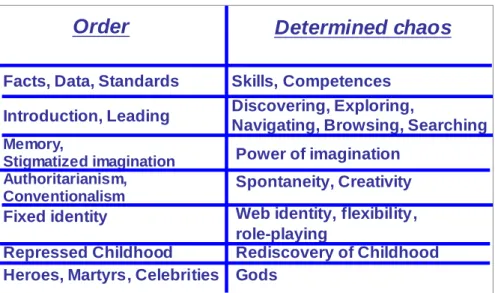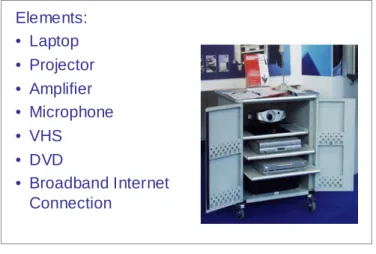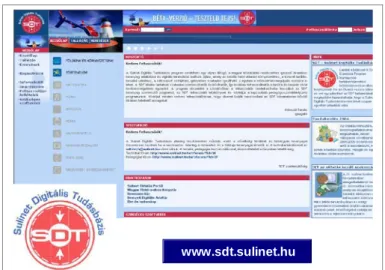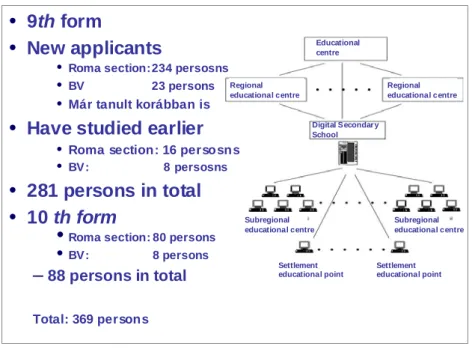György Csepeli
Informatikai és Hírközlési Minisztérium
EFAUST
The Knowledge Revolution
The revolution in technology that is allowing people to transmit and receive in- formation has opened a new age in the history of mankind. The Information Age has radically extended the circle of persons, groups and organisations that are able to communicate with each other, and has done away with the spatial and temporal limits of communication. In possession of new means of info-communication, in principle, anybody can communicate anytime, anywhere, about anything, with any- body. The world is spanned by a uniform, lightning-fast communication network.
Built on this network a continuously widening information source of immense size has evolved, which is accessible, shapeable, extendable by netizens and their organi- sations and groups.
The Information Age is the aggregate of relations and knowledge created by the network. Only the persons, groups, organisations, only the regions of the world, and the nations within each region that can utilise the possibilities of developing an economy and society, which will then be competitive.
These possibilities are focused on knowledge. A competitive society can be cre- ated solely on the basis of knowledge; and knowledge becomes the driving force of economic growth. In order to attain this we must profoundly restructure our con- cepts regarding knowledge. This is necessary because only in possession of these concepts can we understand the role of knowledge required by the Information Age in the development of the economy and society.
The paradigm of knowledge that accorded with the demands of the modern age came into being during the decline of the Middle Ages in Europe. An accorded with Knowledge became an enterprise via which to conquer the physical and biological world. The attempt to acquire new and then even newer information inevitably clashed with the idols standing in the way of the limitless extension of knowledge, which derived their force from ideological, political and social organisations of great influence. The knowledge revolution represented for many the fate of martyrs, the breaking of their personal life, early death. The tragedy of modern knowledge is emblematically represented by the legend of Faust, which was most profoundly written by Goethe. According to the legend, Faust had to ally himself with the devil to satisfy his eager curiosity about the affairs of the world. The source of the tragedy of modern knowledge in the European sense lies in man himself who desires to know, who must unavoidably face the limits of knowledge present not in the outside
world of nature but in his own culture, his demons incomprehensible and uncontrol- lable by reason.
The change in the paradigm of knowledge
In the Information Age the league between Faust and Mephistopheles must be re-alligned.
A new, digital bargain with the devil
Figure 1: A new, digital bargain with the devil
The new information relations and the radical knowledge structures carried by them are the reasons for entering into a new. In the new, global age knowledge be- comes universal in each field of life in an all-embracing way, including the cosmos both inside and outside man. Anyone who becomes part of the Information Society can keep up with accelerating time, while the social life of those left outside may claim the interest of only the cultural anthropologist. In the Information Society the synergy of network-based activities and knowing all leaves no dimension of social existence untouched. The challenges of digital information management, processing, preservation and transmitting technology affect both the government responsible for operating the market, civil society, public policy and the sphere of public service institutions and organisations that deal with research and development. Technologi- cal developments of breathtaking pace continuously devaluate the process knowledge acquired earlier, the maintenance of which would call for a lifelong learning. Consequently, it is the institutions responsible for accumulating, distrib- uting knowledge – from kindergartens to post-university institutions – that must change to the greatest extent, and the most urgently.
Determined chaos
Skills, Competences Discovering, Exploring,
Navigating, Browsing, Searching Power of imagination
Web identity, flexibility, role-playing
Rediscovery of Childhood Spontaneity, Creativity
Order
Facts, Data, Standards Introduction, Leading
Memory,Stigmatized imagination Authoritarianism, Conventionalism
Fixed identity
Repressed Childhood
Heroes, Martyrs, Celebrities Gods
Figure 2: The paradigms of knowledge
In order to understand the order of magnitude of this change it is worth consider- ing the original and the new conditions of Faust’s.
The knowledge of the modern age is based on the assumption of order, the ele- ments of which are facts, data, standards. Knowledge is a process aimed at maintain- ing order, which is moved by the discovery of new data and new facts. The acquisi- tion of knowledge interpreted in this way is shaped in accordance with the pattern of introduction/initiation these by, creating the conventional role pair of the leading, controlling teacher and the student who is led or in need of introduction. The royal way of acquiring knowledge leads through the operation of memory: it is qualified either successful or unsuccessful by examinations coming one after the other. The power of memory stigmatises intuition, creative thinking and imagination, creating the highly influential stereotype of the “deviant genius”. This stereotype is a free pass for everyone who lacks the innovative spirit, creativity and skills to “create a world out of nothing”.
In the Information Age, presuppositions regarding the state of the world change.
It is not order but chaos that becomes the starting-point of cognition, which is a direct challenge as regards organising and creating order, even if the attempt is doomed to fail. Consequently, the aim of cognition cannot be the acquisition of a definitive, “finished” knowledge. It is skills and competencies that underlie cogni- tive activity. During the process of the never-to-be-completed cognition search, navigation, browsing and discovery inevitably come to the forefront. It is not by chance that the names of the software items that facilitate penetration into the Inter- net come from just these words. Compared to the earlier situation, it will be neces-
sary to operate the memory capacity of the brain to a much lower extent as proper search programs and solutions carrying artificial intelligence elements from the realm of knowing-all made accessible by the Internet are able to replace classical memory functions.
The possibilities offered by the system of means of the Information Age present themselves in a natural way for the child’s curiosity, spontaneity and experimenting.
Therefore, it is important that as early as before school age, from the age of 4-5, new info-communication means are made available to children. Children will be able to set out on the new genetic path of epistemology if they can continually try out these new means, can continuoually experiment with them, and by using them can devel- op new manipulation skills. The Information Age provides children with a technical environment that is very much in line with the openness typical of a child’s spirit, and this can fill the magic phase of early childhood with new content. The effect will be lasting. Anyone socialised (also) by using tools provided by the Information Age will not later need to suppress or conceal his one-time child’s ego in order to fully meet the expectations regarding his adult roles. The Information Society re- evaluates childhood, and promises success to adults who do not reject the child in- side who they once were.
In the Information Age adults gain from the spontaneity, creativity and imagina- tion experienced in childhood. As a result of the operation of these psychological forces the concept of normality is transformed. It is adults who remain children in their spirit while their sensibilities and actions are lead by the problems of natural and social reality, which can be successful and acknowledged. The role models of people living in the Information Age are not the heroes and martyrs of the past, not the celebrities of the present (often with passing effect) but the gods of Greek my- thology, of whom it is said that they were born “in the normal childhood of man- kind”.
Faust is the ideal type of the European actor, who, being eager to learn, allies himself with the devil. In the Information Age this alliance must be re-examined.
The only question is what the conditions of the new, digital between Faust and the devil will be.
School in the Information Age
In the new situation the role of the educator radically changes. While in the pred- igital age he was the guardian and monopolist of knowledge, the students’ control- ler, with unquestionable authority, in the new age the role of the pedagogue can be compared to that of a pilot, who undertakes to discover the unknown, who is learn- ing together with his/her students.
Student
• Personalization
• Success
• Creativity
• Interaction
• Integration
• Participation
Instructur
• Development
• Shared experience
• Autonomy
• Creativity
• Involvement
Institution
•Accountability
•Data- managment
•Control of quality
•Tracking
Figure 3: Changes in education within the new infocommunication environment
Contrary to the “frontal” pedagogical method applied earlier, the new methods make it possible to follow up students’ knowledge developments and to give stu- dents tailor-made tasks.
Building and interaction into the system of education enhances the probability of somone’s having a real sense of achievement, which brings about a rise in motiva- tion level. By making use of data stores, knowledge bases, educational auxiliary materials and multimedia programs available on the Internet, teacher can make the pedagogical event more attractive, more successful, one which can get away from the space and time format of a “lesson”. Through videoconference tools classes can establish direct contact with the students of other classes, can become witnesses to scientific expeditions, can listen to the presentations of international experts either live or on archived recordings. All this can release teachers’ creativity and autono- my, can encourage teachers to discover new didactic possibilities. The application of infocommunication tools radically changes the operations of organisations engaged in education. The uniform and standardised informatics system facilitates admin- istration, the maintenance of relations with other organisations and authorities, and makes them transparent and controllable. Transactions between teachers and stu- dents can be followed upon, which allows quality assurances, identification and the elimination of elements that endanger successful education.
A Minister of the Hungarian Government, Mr. Bálint Magyar initiated the Su- linet Program as early as 1996; under this program the Internet was made available at hundreds of schools in Hungary. At the time of launching the program schools could be connected to the Internet on a narrow band, which made it by no means possible for the knowledge revolution to develop in schools, but it was good for teachers to become familiar with the new technology and made persons curious about new possibilities. The Sulinet Program slowed down in the years 1998–2002.
In the new government (formed after the elections in 2002) the field of informatics and communications is represented by a ministry: the Ministry of Informatics and Communications together with the Ministry of Education have created the Public
Network, which makes it possible for all schools in Hungary to have broad band access to the Internet service. Through satellite technology, schools outside the bor- ders also now have this opportunity. Access to the broad band Internet can be made possible through wireless technologies, the setting up of local networks in the build- ing as a whole and on specific premises (e.g. also in a courtyard).
It will be possible to utilise broad band access to the Internet if teachers are pro- vided with means that are able to receive and store masses of data and then forward them to students. This aim is served by the Digital cart, which is now available at all secondary educational institutions in Hungary.
Elements:
• Laptop
• Projector
• Amplifier
• Microphone
• VHS
• DVD
• Broadband Internet Connection
Figure 4: Digital cart
The digital cart carries a high capacity portable PC, which is linked with the In- ternet. A projector and a sound amplifier help to provide presentations. Accessories include a DVD and a VHS player, and a microphone. For the future it is worth fur- ther widening the supply of means to include a digital camera and a digital video camera.
In the information society the classroom is both a physical space where the stu- dents and the teacher meet and a point from where any other point in the world can be reached (i.e. where an Internet connection is operated). It is just as important that Internet-based databases, encyclopaedias and knowledge “gardens” stored on a cen- tral server, libraries, archives, museums, private collections can be accessed from the classroom connected to the Internet. The teacher’s task is to teach students how to use the possibilities provided by a classroom opened up to an infinity of oppor- tunity in order to enhance their knowledge.
In Hungary the Government has invested huge amounts of money in developing digital contents suitable for school education while organising them into a system accessible to school education. The system of the Digital Knowledge Base (www.sdt.sulinet.hu) was set up in 2003, and is being continually enhanced. Its content classes span the entire range of subjects taught in public education.
www.sdt.sulinet.hu
Figure 5: The homepage of the Sulinet Digital Knowledge Base
Teaching and learning are helped by the National Digital Data Archive; by ac- cessing it, teachers and students can become connected with the decentralised net- work of digital content development initiatives. This network is ready and willing to include any content owner who undertakes to comply with the technological and data transmission rules of the NDDA.
••Decentralized network of digital content development initiatives
•Standardized technological and data transmission processes
•Standardized metadatabase, search engine
•Public access and micro payment
•Market compatible solution
•Sample of results:
•www.enc.hu
•http://gis.geox.hu/karpat/
•www.neumann-haz.hu
•www.hung-art.hu
•www.centropa.hu
www.nda.hu
Figure 6: The organisational structure of the National Digital Data Archive The social changes that have accelerated in the Information Age make lifelong learning necessary. Consequently, it is a necessity for employees, entrepreneurs and
managers to maintain their knowledge and to take continually part in further train- ing. These training functions can be implemented efficiently, quickly and in a way satisfactory for masses of people only through e-learning solutions. Unfortunately, in Hungary there are many people who have been omitted from the system of tradi- tional public education and who do not have elementary or secondary qualifications, either. In order to train this target group, the government launched the Digital Sec- ondary School in September 2003 (www.digitaliskozepiskola.hu), this being a school that has no actual building that students can enter –instead, it goes to the students. Teachers prepare online syllabuses, and maintain online connection with students (N.B. they live in the draw area of the town of Miskolc). Education is car- ried out in subject blocks. The digital educational auxiliary material fits into the secondary school teaching program, but in terms of information content it is more than this. Each subject block includes pictures, music, films and recommendation of links accessible on the Internet. The success of one’s learning can be checked wia practising tests.
Digitális Középiskola
• 9th form
• New applicants
• Roma section:234 persosns
• BV 23 persons
• Már tanult korábban is
• Have studied earlier
• Roma section: 16 persosns
• BV: 8 persosns
• 281 persons in total
• 10 th form
•
Roma section: 80 persons•
BV: 8 persons–
88 persons in totalTotal: 369 persons
Educational centre
Regional educational centre
Regional educational centre
Digital Secondar y School
Settlement educational point Settlement
educational point Subregional
educational centre
Subregional educational centre
Figure 7: The Digital Secondary School
The e-learning framework was developed for and delivered to the Digital Sec- ondary School by Matáv1. It allows for continuous relations between student and teacher, and participation in or chatting in various thematic forums. The system also offers a search function. Once a month, students can meet their teachers personally.
These meetings are held at 11 subregional Educational Centres. The endpoint of
1 Matáv is the largest telecom company in Hungary.
such education is the Settlement Educational Point, where each student can individ- ually access online syllabuses, use information transmitted through the Internet and communicate with their classmates and teachers.
The activity of the Digital Secondary School is continually monitored. The num- ber of persons who have undertaken to actually study is much less than that of appli- cants. Among those who complete the first year, drop-out stops. During content monitoring, researchers have made several surveys. They have examined changes in the level of knowledge regarding each subject-which is neither lower, nor higher than the average. They have separately surveyed skills persons’ of understanding texts of and their readiness to solve maths problems. Regarding the results of the reading test it can be said that students of the Digital Secondary School are on the level of fifth-form pupils in the regular national education system. Maths problem- solving also lags significantly behind the aforesaid level. Only the level of learning motivation is high.
On the grounds of the positive experience gained in this first two years, plans have been made to extend the Digital Secondary School. It is obvious that ethnic Hungarians living abroad, for whom in many cases this is the only opportunity to complete secondary school studies in Hungarian, should be able to use the school’s services. Southern-Baranya has similar conditions to those of Northern Hungary:
here, training can also be started. There is also a significant proportion of adults who did not complete their elementary school studies and Because of this it would be worth setting up a Digital Elementary School for such leavers from the basic public school system. As a separate program, an electronically transmitted vocational spe- cial training will also be implemented because completion of studies in general sub- jects in itself is not enough when it comes to entering the labour market.
The New Arcadia
In the 21st century the nations and regions that recognise that knowledge and economic growth are interrelated will be successful. The exploitation of the econom- ic and social possibilities implied in knowledge depends on to what extent popula- tion is able to access the communication points of the broad band infrastructure and, as a part of this, how the big creative groups can, too, i.e. whose members may be- come the driving force of economic/social innovations (by communicating with each other and the other creative centres of the world). According to the American soci- ologist, Richard Florida, who has acquired as international reputation as the creative class theoretician, changes in economic and social development can be described with the following variables:
1. The proportion of those carrying out creative work among employees.
2. The proportion of high technology production within the entire production volume.
3. The number of patents.
4. The proportion of those not living in a nuclear family within the adult popula- tion.
www .ihm.hu
Figure 8: New Arcadia
If the value of these four variables are high, then it can be expected that new ide- as will be continuously formed in society and new enterprises will develop from these ideas, ones which will be able to break into the market with new products and services, thus launching the development of the region by doing so. The creative class is typically an open social group, which, owing to its international, multicul- tural composition, excludes provincialism and the monopolisation of knowledge from the first moment. The members of the creative class must come together both in virtual and physical space; and such physical spaces (university campuses, knowledge parks) will become the collective “scenes” of the lives of scientists, art- ists, entrepreneurs, inventors – where Mephistopheles might also feel at home.
Bibliography
Florida, R. 2002. The Rise of the Creative Class: And how Its Transforming Work, Leisure, Community, and Everyday Life. New York. Basic Books.
Dessewffy, T. 2004. Bevezetés a jelenbe. Budapest. Nemzeti Tankönyvkiadó.
György, P. 2002. Memex. Budapest. Magvető.
Nyiry, K. 2004. Vernetztes Wissen: Philosophie im Zeitalter des Internets. Vienna.
Passagen Verlag.
Z.Karvalics L. 2000. Fogpiszkáló a hálózaton. Budapest. Prím.






